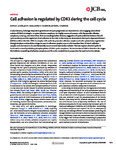Cell adhesion is regulated by CDK1 during the cell cycle
| dc.contributor.author | Jones, MC | |
| dc.contributor.author | Askari, JA | |
| dc.contributor.author | Humphries, JD | |
| dc.contributor.author | Humphries, MJ | |
| dc.date.accessioned | 2023-01-04T11:33:08Z | |
| dc.date.issued | 2018-09-03 | |
| dc.identifier.issn | 0021-9525 | |
| dc.identifier.issn | 1540-8140 | |
| dc.identifier.uri | http://hdl.handle.net/10026.1/20134 | |
| dc.description.abstract |
In most tissues, anchorage-dependent growth and cell cycle progression are dependent on cells engaging extracellular matrices (ECMs) via integrin–receptor adhesion complexes. In a highly conserved manner, cells disassemble adhesion complexes, round up, and retract from their surroundings before division, suggestive of a primordial link between the cell cycle machinery and the regulation of cell adhesion to the ECM. In this study, we demonstrate that cyclin-dependent kinase 1 (CDK1) mediates this link. CDK1, in complex with cyclin A2, promotes adhesion complex and actin cytoskeleton organization during interphase and mediates a large increase in adhesion complex area as cells transition from G1 into S. Adhesion complex area decreases in G2, and disassembly occurs several hours before mitosis. This loss requires elevated cyclin B1 levels and is caused by inhibitory phosphorylation of CDK1–cyclin complexes. The inactivation of CDK1 is therefore the trigger that initiates remodeling of adhesion complexes and the actin cytoskeleton in preparation for rapid entry into mitosis. | |
| dc.format.extent | 3203-3218 | |
| dc.format.medium | Print-Electronic | |
| dc.language | en | |
| dc.language.iso | eng | |
| dc.publisher | Rockefeller University Press | |
| dc.subject | Actin Cytoskeleton | |
| dc.subject | CDC2 Protein Kinase | |
| dc.subject | Cell Adhesion | |
| dc.subject | Cell Line, Tumor | |
| dc.subject | Cyclin A2 | |
| dc.subject | Cyclin B1 | |
| dc.subject | HeLa Cells | |
| dc.subject | Humans | |
| dc.subject | Mitosis | |
| dc.subject | Phosphorylation | |
| dc.title | Cell adhesion is regulated by CDK1 during the cell cycle | |
| dc.type | journal-article | |
| dc.type | Article | |
| plymouth.author-url | https://www.ncbi.nlm.nih.gov/pubmed/29930204 | |
| plymouth.issue | 9 | |
| plymouth.volume | 217 | |
| plymouth.publication-status | Published | |
| plymouth.journal | Journal of Cell Biology | |
| dc.identifier.doi | 10.1083/jcb.201802088 | |
| plymouth.organisational-group | /Plymouth | |
| plymouth.organisational-group | /Plymouth/Faculty of Health | |
| plymouth.organisational-group | /Plymouth/Faculty of Health/Peninsula Medical School | |
| plymouth.organisational-group | /Plymouth/REF 2021 Researchers by UoA | |
| plymouth.organisational-group | /Plymouth/REF 2021 Researchers by UoA/UoA01 Clinical Medicine | |
| plymouth.organisational-group | /Plymouth/Users by role | |
| plymouth.organisational-group | /Plymouth/Users by role/Academics | |
| dc.publisher.place | United States | |
| dcterms.dateAccepted | 2018-05-29 | |
| dc.rights.embargodate | 2023-8-5 | |
| dc.identifier.eissn | 1540-8140 | |
| dc.rights.embargoperiod | Not known | |
| rioxxterms.versionofrecord | 10.1083/jcb.201802088 | |
| rioxxterms.licenseref.uri | http://www.rioxx.net/licenses/all-rights-reserved | |
| rioxxterms.licenseref.startdate | 2018-09-03 | |
| rioxxterms.type | Journal Article/Review |


